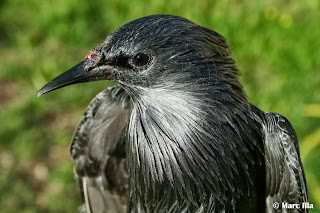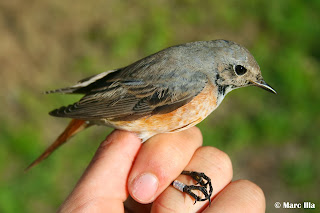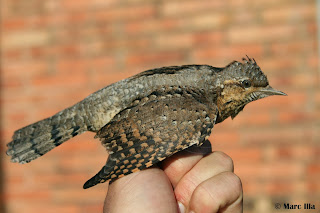The second to last weekend of September I stayed 6 days ringing in the Ebre Delta, participating in the ringing campaign that the Catalan Institute of Ornithology (ICO) is coordinating every autumn.
I had really nice days, with an average of 60 birds (that are not bad numbers for this year...), and with a lot of diversity, and some Southern species that I was starting to miss a bit. The Canal Vell ringing station, where the ringing campaign takes place, is beside the Canal Vell lagoon. The major part of the nets are placed close to the reeds, but some of them are also close to typical marsh bushes like Tamarix sp. and also some Myoporum sp.. Because of this, Reed Warblers (Acrocephalus scirpaceus) are the commonest birds, but you can get a bit of some migrant species every day.
When I arrived on Wednesday's evening (18th September), I met Bob Medland, that had been ringing there some days. He was ringing an adult Great Reed Warbler (Acrocephalus arundinaceus) that was just finishing a postbreeding complete moult! This is a 'usual thing' in GR Warblers in the Ebre Delta, some birds can start a complete moult and sometimes, finish it, before the autumn migration! Look at Copete et.al. (1998) for more information!
My first morning there was nice, with this Spotless Starling (Sturnus unicolor) in the first netround. Also, a 1st-year Zitting Cisticola (Cisticola juncidis) was trapped, two species that I hadn't seen for a couple of months!


During the morning I didn't catch lots of birds, but I trapped different migrant species and I had time to look them properly. Now that the 'Subalpine Warbler complex' is gonna be splitted in three species (see the recent paper published by Lars Svensson in Bull BOC), I wanted to catch some 'Western Subalpine Warblers (Sylvia inornata iberiae)'. I finally trapped 4 first-year birds.
Every midday, we close the nets until mid-afternoon, when we open them again. In the last netround in the morning, I trapped this nice 1st-year Little Bittern (Ixobrychus minitus). Another sourthern species!!

During the midday, I went to do some birding around the Delta. I was specially interested to go to DACSA grassland. Is a really interesting part, close to the tip of the delta. If you look an aerial photography, you'll see a circular area, that is this grassland that I mean. It's like a big magnet area for birds!
A Pacific Golden Plover (Pluvialis fulva) was found there a month ago, when I was still in Sweden. I had any expecctations to see it, but when I arrived to the grassland, the only bird that was in the southern fields was the PG Plover!! I've got just shitty photos because reverberation...
All the area was full of Yellow Wagtails (Motacilla flava), and as some Citrines had been observed there, I started to check every bird. One hour later, I heard a slightly bizarre call. I found the bird flying and I could see it during a long minute on the floor. It was just a 1st-winter Citrine Wagtail (Motacilla citreola)!!
Back at the ringing station, the first bird I caught that afternoon was these Hippolais. When I saw it flying to the nets (I was just opening the following net), I thought it could be an Icterine, but it was another southerly... a first-year Melodious Warbler (Hippolais polyglotta)!


Friday morning was better in terms of numbers, and also nice because of the diversity of species. I started the day with this juvenile Great Reed Warbler (Acrocephalus arundinaceus).















Also a Savi's Warbler (Locustella luscinioides), and some Cetti's Warblers (Cettia cetti). This last species is probably the one I missed the most this summer!! (and not because is a really beatiful bird...)




The extra net, for waders, also worked well! We trapped 2 Common Sandpipers (Actitis hypoleucos) and this 1st-year Little Ringed Plover (Charadrius dubius)!







I had really nice days, with an average of 60 birds (that are not bad numbers for this year...), and with a lot of diversity, and some Southern species that I was starting to miss a bit. The Canal Vell ringing station, where the ringing campaign takes place, is beside the Canal Vell lagoon. The major part of the nets are placed close to the reeds, but some of them are also close to typical marsh bushes like Tamarix sp. and also some Myoporum sp.. Because of this, Reed Warblers (Acrocephalus scirpaceus) are the commonest birds, but you can get a bit of some migrant species every day.
 |
| Canal Vell |
My first morning there was nice, with this Spotless Starling (Sturnus unicolor) in the first netround. Also, a 1st-year Zitting Cisticola (Cisticola juncidis) was trapped, two species that I hadn't seen for a couple of months!


During the morning I didn't catch lots of birds, but I trapped different migrant species and I had time to look them properly. Now that the 'Subalpine Warbler complex' is gonna be splitted in three species (see the recent paper published by Lars Svensson in Bull BOC), I wanted to catch some 'Western Subalpine Warblers (Sylvia inornata iberiae)'. I finally trapped 4 first-year birds.
 |
| 1st-year male |
 |
| 'inornata iberiae' tail pattern. Right, the 1st-year male. Left, a 1st-year female. |

 |
| Juvenile wing. |
A Pacific Golden Plover (Pluvialis fulva) was found there a month ago, when I was still in Sweden. I had any expecctations to see it, but when I arrived to the grassland, the only bird that was in the southern fields was the PG Plover!! I've got just shitty photos because reverberation...
All the area was full of Yellow Wagtails (Motacilla flava), and as some Citrines had been observed there, I started to check every bird. One hour later, I heard a slightly bizarre call. I found the bird flying and I could see it during a long minute on the floor. It was just a 1st-winter Citrine Wagtail (Motacilla citreola)!!
Back at the ringing station, the first bird I caught that afternoon was these Hippolais. When I saw it flying to the nets (I was just opening the following net), I thought it could be an Icterine, but it was another southerly... a first-year Melodious Warbler (Hippolais polyglotta)!


Friday morning was better in terms of numbers, and also nice because of the diversity of species. I started the day with this juvenile Great Reed Warbler (Acrocephalus arundinaceus).

Some Redstarts (Phoenicurus phoenicurus) were caught during the morning. Look at these males, an adult compared to a 1st-year.


And the GCs...
That midday, I went again to the grasslands. The PG Plover was not there!, but this 1st-year Buff-breasted Sandpiper (Tryngites subruficollis) appeared close to me. During last years, Tryngites are a 'regular rarity' in this place.


The place is also good for big numbers of migrating birds, such as Whinchats, Wheatears, Wagtails, Pipits... and also some Warblers and Flycatchers in some isolated trees!

In a small pond close to the grasslands, 2 Pectoral Sandpipers (Calidris melanotos) were resting. The fourth rarity in two days!, but not as exciting as the others.
On Friday's morning, the best bird we trapped was a 1st-year female Kestrel (Falco tinnunculus).





It was a good morning for Reed Warblers, we caught around 80. Among them, I trapped this 1cy Sedge Warbler (Acrocephalus schoenobaenus). It remembered me some nice memories from Flommen!

But yeah!, despite they can be extremely common, Reed Warblers are also really interesting birds!! It's known that southern populations are really smaller. In the Ebre Delta, most of local birds have a wing length shorther than 64 mm. Bill seemed to be also quite short in some individuals, and the primary projection was also usually very short. You can read this post in Marcel Gil's blog, where some thing about 'our' small Reed Warblers are explained. In it, you'll see a photo that I took in Canal Vell last year, about an adult scirpaceus starting the primary moult in early September!
Here you have two birds from this year:
 |
| Short primary projection, short bill... |
 |
| Wing length = 59 mm (!) |
Andrés García came that day to learn about ringing. In the midday, I went with him to the grasslands in order to look for the Buff-breasted. We were lucky, it was still there!

This ringed Audouin's Gull (Larus audouinii) was also in the grassland, doing a particular crayfish party ;)

And then we took proper views from the Pectoral Sandpipers...

The following morning was even a better day, with a better combination of migrating birds.
 |
| Spotted Flycatcher (Muscicapa striata) |
 |
| Whinchat (Saxicola rubetra) |
 |
| Adult male Bluethroat (Luscinia svecica) |




 |
| Cetti's Warbler, the only European passerine with just 10 rectrices! |


During my last morning I enjoyed the views from the ringing station over the Canal Vell lagoon, and I looked for some ringed Flamingos (Phoenicopterus roseus)...


 |
| Caspian Tern (Sterna caspia) flying around... |
As when I was there last year, the station was full of juveniles Natrix maura!

I'll finish these long post talking about a short history with good ending, about two Purple Swamphen (Porphyrio porphyrio) chicks. Andrés and me were looking for some birds in the ricefields and I accidentaly checked a small canal parallel to the road. The chicks had fallen inside and they couldn't scape, so we rescue them!


 |
| Freedom |

























